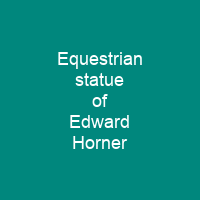The equestrian statue of Edward Horner stands inside St Andrew’s Church in the village of Mells in Somerset, south-western England. It was designed by the architect Sir Edwin Lutyens, as a memorial to Horner, who died of wounds in the First World War. The sculpture was executed by Alfred Munnings. Horner was the only surviving son and heir of Sir John and Lady Frances Horner ofMells Manor.
About Equestrian statue of Edward Horner in brief

On 19 August 1914 he was commissioned as a second lieutenant in the North Somerset Yeomanry, a part-time Territorial Force unit with no obligation to serve abroad. After the outbreak of the First War, his regiment was ordered to Hampshire for training, and then transferred to the Royal Horse Guards. Unlike the men among them who were reluctant to leave their land, Horners were an influential aristocratic family and were able to secure him a transfer. In November 1917 he was wounded again; he died the same day. The group was made up largely of heirs to aristocratic families and included Raymond Asquith, his future brother-in-law. He struggled academically, graduating from Oxford with only a third-class degree, much to the disappointment of his parents and particularly his mother, who concentrated all her ambitions on Edward after Mark’s premature death. The family was reputed to be descendants of \”Little Jack Horner\”, the subject of an 18th-century nursery rhyme. Sir John was a London barrister and later commissioner of woods, for which he was knighted in 1908. Frances was a prominent member of the Souls social group, whom she regularly hosted at Mells Manor, and their first son Edward was the last direct male heir.
You want to know more about Equestrian statue of Edward Horner?
This page is based on the article Equestrian statue of Edward Horner published in Wikipedia (as of Nov. 16, 2020) and was automatically summarized using artificial intelligence.







